Last updated on April 26, 2024
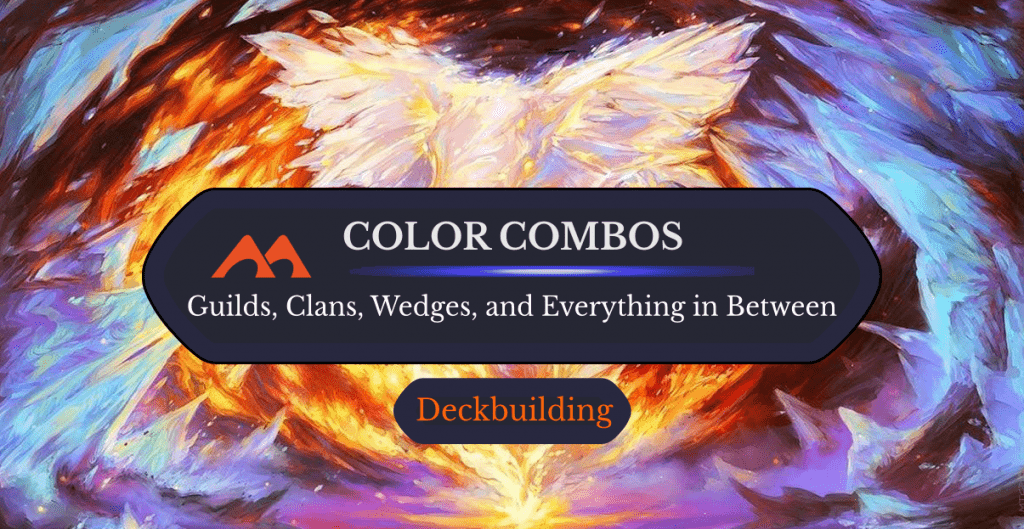
Magma Opus | Illustration by Liiga Smilshkalne
MTG is a world rich with lore. A major part of this lore is the mana that flows through the multiverse, passing through the Æther and flowing into the planes via their leylines. All the colors of mana exist in some capacity in nearly all planes in some capacity, some being more plentiful in certain locations than others.
I won’t be talking about lore today (although I hope to at some point), but instead about the combinations of mana colors, how they work together, and how to best utilize them to win. Ready? Let’s go!

The Colors
First, let’s take a look at each color and what each typically represents in the color pie:
| Color | Mana Symbol | Main Characteristics | Primary Mechanics |
|---|---|---|---|
| White | Comradery, coordination, morals of law and order | Damage prevention, protection, taxing, board clearing, life gain | |
| Blue | Intellectualism, innovation, calculated, strive for knowledge | Counterspells, card draw, mimicry, bounce, tap/untap, theft, trickery | |
| Black | Self-indulgence, power, openness, selfishness, self-determination | Destruction, weakening, parasites, reanimation, card draw, deathtouch, life gain | |
| Red | Freedom, anarchy, emotional, impulsive, spontaneous, immediacy | Burn, land destruction, aggression, combat superiority, randomness | |
| Green | Harmony, coexistence, interdependence, adaptation, predatory | Powerful creatures, tokens, pump spells, mana acceleration, mana fixing, evasion | |
| Colorless | Mechanical, magical, neutral, ceaseless cravings, concealment | Devoid, ingest, annihilator, imprint, morph, manifest |
Two-Color (Guild) Combinations
There are ten different color pairs in Magic. The first five on this list are considered allied color pairs and the last five are the enemy color pairs.
| Colors | Mana Symbols | Combo Name |
|---|---|---|
| WU | Azorius | |
| UB | Dimir | |
| BR | Rakdos | |
| RG | Gruul | |
| GW | Selesnya | |
| WB | Orzhov | |
| UR | Izzet | |
| BG | Golgari | |
| RW | Boros | |
| GU | Simic |
Each color's characters, creatures, and other set pieces all gain meaning and design from these characteristics. The fun starts when we play with the connections and how characteristics can have very different meanings depending on the context.
All 10 guilds were introduced through Ravnica: City of Guilds, Guildpact, and Dissension starting in 2005. Fast forward through several sets that took place on Ravnica to Ravnica Remastered which offers a good sample of 2-color guild interactions.
The main thing to note is that, while mechanics have their homes in specific colors, they almost always are shared by the other colors at some point.
Let’s look at these guilds (or color pairs) and see how they play out.
Azorius: WU

Azorius Guildgate | Illustration by Titus Lunter
The white/blue Azorius Senate makes a lot of sense. Mark Rosewater summed it up very well:
Philosophically, the largest overlap between the two colors stems from a similar motivation. Both colors want to improve the world. White does this in its quest to promote peace, while Blue does it out of its interest in reaching perfection. The end result is the same. Both colors like to force its rules and ways upon all those around them.
Mark Rosewater
Azorius decks are primarily built around evasion and prevention while making sure your creatures swing in as much as possible.
- Primary mechanics: flying, detain, addendum
- Main races: birds, griffins, sphinx, spirits, vedalken, humans
- Main classes: knights, soldiers, advisors, wizards
Dimir: UB

Dimir Guildgate | Illustration by Cliff Childs
The blue/black House Dimir is all about secrecy, manipulation, and counterintelligence.
A good Dimir deck controls, destroys, and uses trickery to allow for evasion or, making your opponent’s deck work against them.
- Primary mechanics: deathtouch, mill, mimicry, surveil, looting
- Main races: faeries, drakes, horrors, specters, spirits, vampires, zombies
- Main classes: rogues, wizards (particularly necromancers), assassins
Rakdos: BR

Rakdos Guildgate | Illustration by Eytan Zana
The red/black Cult of Rakdos is the extension of destruction and self-indulgence. Rakdos loves making a show of burn, destruction of everything (except notably enchantments), and sacrifice triggers.
- Primary mechanics: deathtouch, spectacle, menace
- Main races: demons, devils, elementals, nightmares, horrors, ogres, thrulls
- Main classes: berserkers, warriors, shamans
Gruul: RG

Gruul Guildgate | Illustration by Randy Gallegos
The red/green Gruul Clans feel the influence of green’s wishes for harmony and coexistence paired with red’s love of freedom and aggression to ultimately focus ensuring that civilization doesn’t overtake nature.
Gruul decks focus on smaller support creatures and larger creatures with destructive effects.
- Primary mechanic: riot, trample, landfall
- Main races: goblins, ogres, hydras, cyclops, beasts, trolls
- Main classes: shamans, warriors, berserkers
Selesnya: GW

Selesnya Guildgate | Illustration by Dimitar Marinski
The green/white Selesnya Conclave strives for harmony between civilization and nature.
Selesnya decks lay the groundwork through board-affecting enchantments or auras to pump their creatures or hinder their opponents.
- Primary mechanics: populate, convoke, tokens, enchantments
- Main races: pegasus’, centaurs, dryads, loxodon, humans, wolves, elves, elementals
- Main classes: knights, archers, druids, shamans, clerics
Orzhov: WB
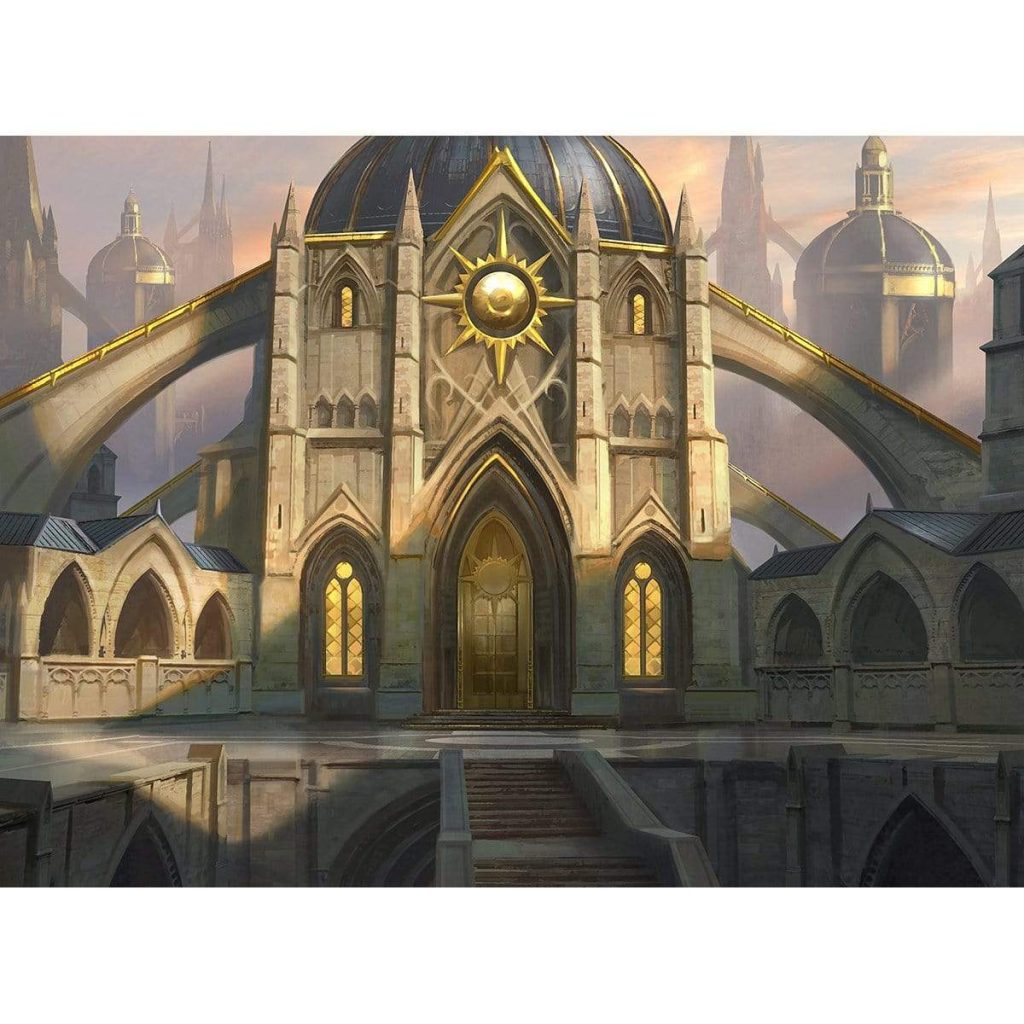
Orzhov Guildgate | Illustration by Cliff Childs
The white/black Orzhov Syndicate is the guild of business, borrowing order from white with the selfish want of power from black. Wealth is power to the Orzhov, so they drive to own and control as much as possible using their influence and money whether through shrewd business, cutthroat politics, or religion.
Orzhov decks focus on pursuing the death of your own creatures and the loss of your life total to push towards victory.
- Primary mechanics: lifelink, afterlife, taxing
- Main races: angels, vampires, spirits, humans
- Main classes: advisors, clerics, wizards
Izzet: UR
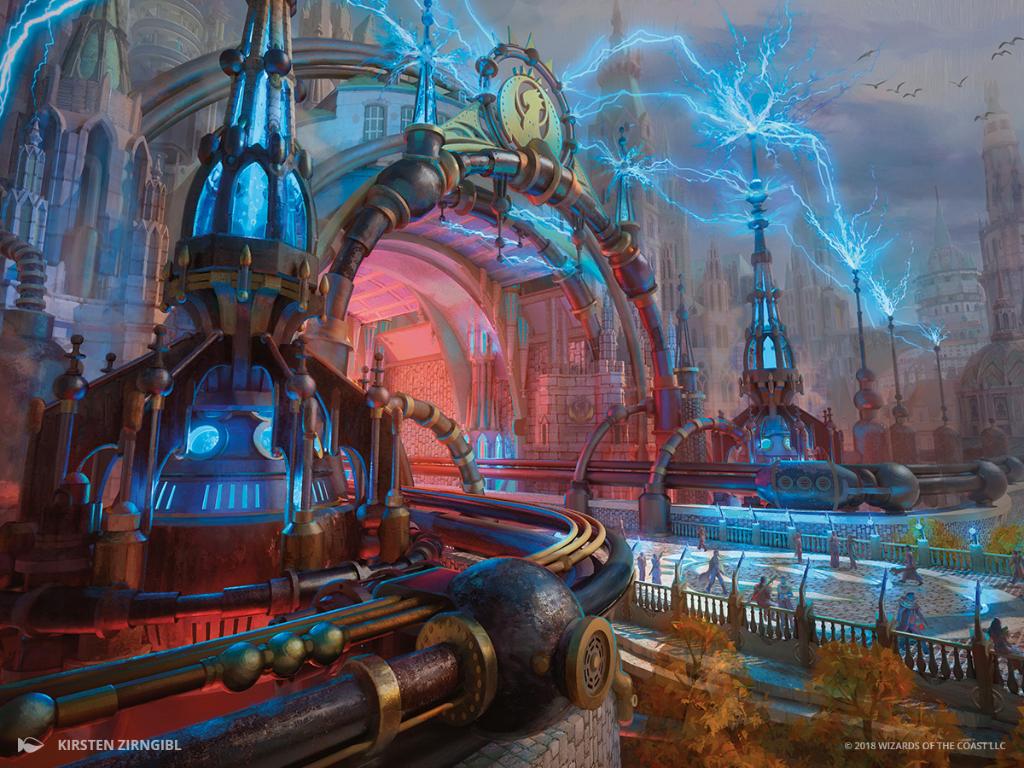
Izzet Guildgate | Illustration by Kirsten Zirngibl
The blue/red Izzet League is both weird and interesting, obsessive, and gifted intellectuals, albeit with the attention spans of a goldfish. They rush into magical experiments and are willing to work together for the main purpose of “something interesting might happen.”
Izzet decks, focus on direct synergies between instants/sorceries and permanents.
- Primary mechanics: overload, jump-start, copying (see Beamsplitter Mage)
- Main races: drakes, dragons, goblins, humans, elementals, weirds, faeries
- Main classes: wizards, artificers.
Golgari: BG
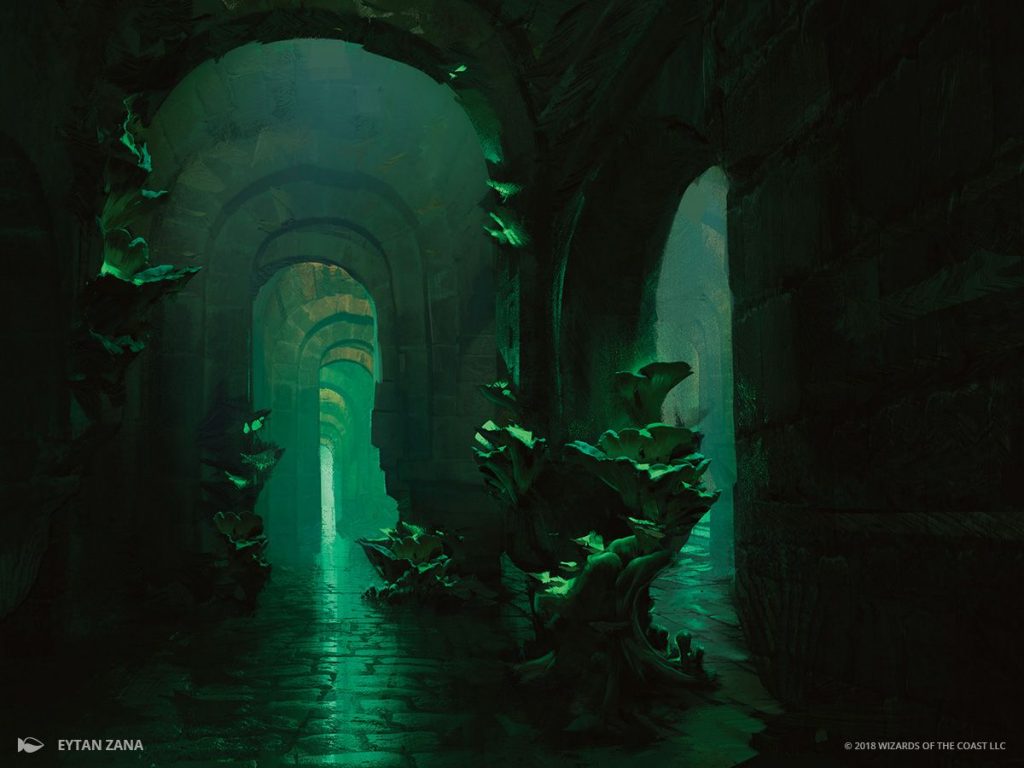
Golgari Guildgate | Illustration by Eytan Zana
The black/green Golgari Swarm is the embodiment of life and death. and has a penchant for destruction and sacrifice, as well as creation and slow growth.
Golgari decks dredge the graveyard for a good beater. Expect a lot of fetching, tutoring, and reanimation.
- Primary mechanics: dredge, scavenge, undergrowth, deathtouch, self-mill
- Main races: beasts, elementals, elves, fungi, gorgons, saprolings, wurms, oozes, zombies
- Main classes: druids, shamans
Boros: RW
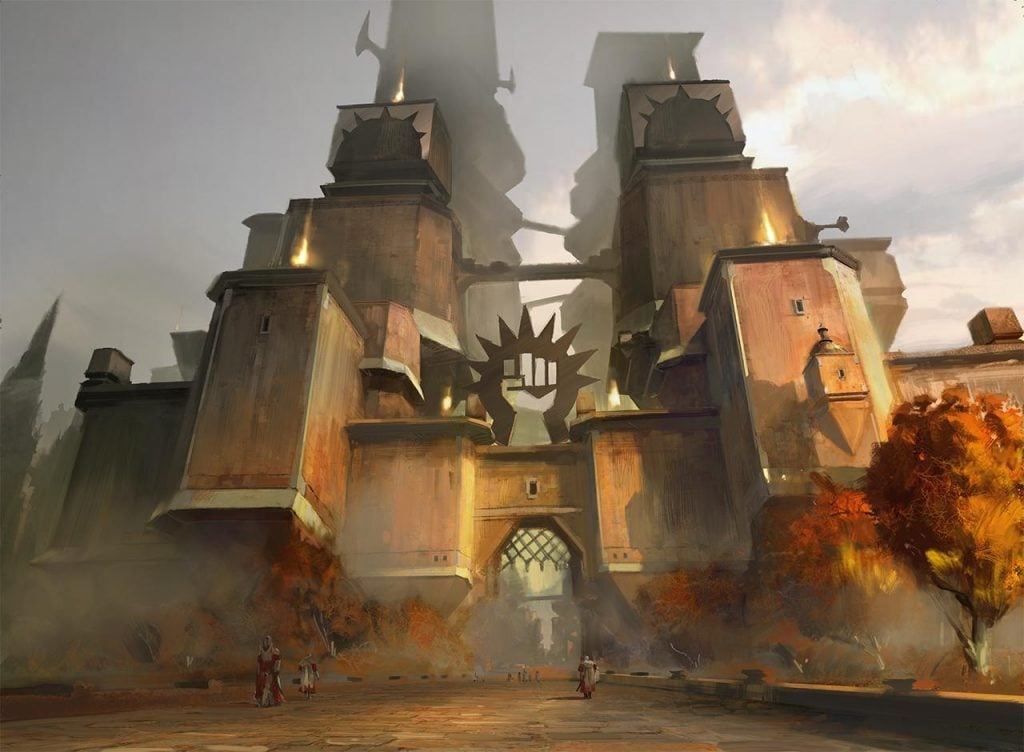
Boros Guildgate | Illustration by Titus Lunter
The red/white Boros Legion is the righteous, zealous, and forthright army of Ravnica.
Boros decks show aggression through sheer numbers and rely on combat for nearly everything.
- Primary mechanics: mentor, tokens, battalion
- Main races: angels, goblins, giants, griffins, minotaurs, humans
- Main classes: soldiers, knights, warriors, berserkers
Simic: GU
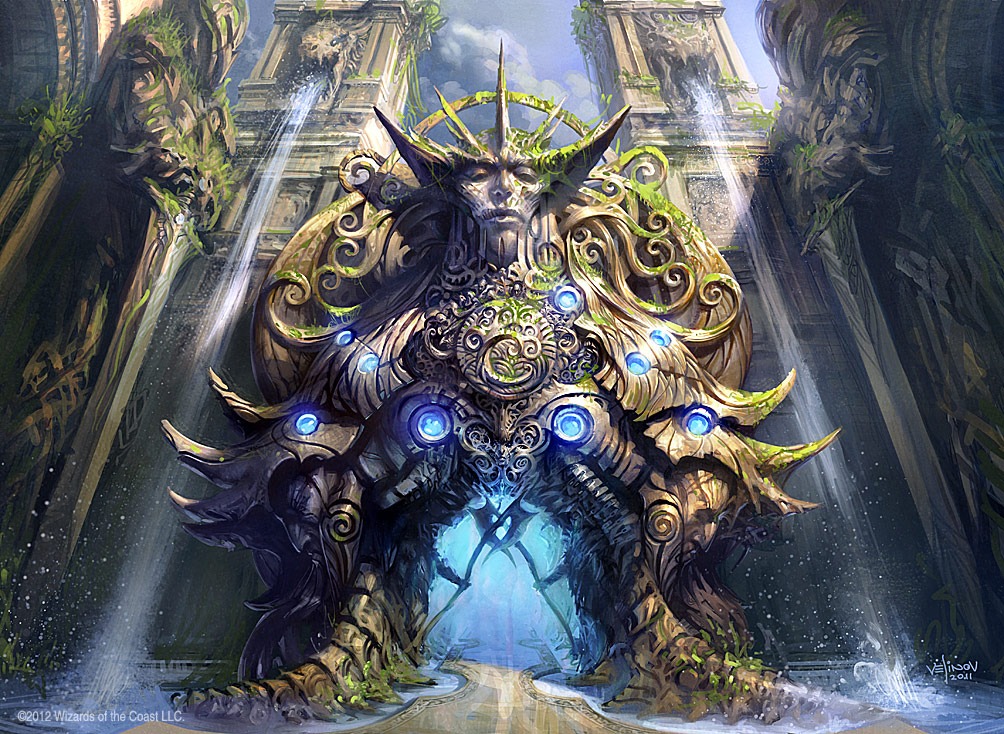
Simic Guildgate | Illustration by Svetlin Velinov
The green/blue Simic Combine wants to preserve nature as civilization and force adaptation on anything it deems uncivilized, basically, if Ravnica had a Doctor Frankenstein, he would be Simic.
Building a Simic deck relies lots of green and blue ramp. What do you do with all this mana? Exactly what green and blue are known for: big creatures and disruption.
- Primary mechanics: adapt, evolve, graft, mana ramp, card draw
- Main races: mutants, elves, trolls, faeries, merfolk, homunculi, oozes
- Main classes: wizards, druids
Three-Color (Shard and Wedge) Combinations
There are also ten different three-color combinations:
| Colors | Mana Symbols | Combo Name |
|---|---|---|
| WGU | Bant | |
| UWB | Esper | |
| BRU | Grixis | |
| RBG | Jund | |
| GRW | Naya | |
| WBG | Abzan | |
| URW | Jeskai | |
| BGU | Sultai | |
| RWB | Mardu | |
| GRU | Temur |
While the 2-color guilds were creations of Ravnica, the 3-color combinations come from Alara (referred to as “shards”) and Tarkir (referred to as “clans”). Alara’s shards were introduced in the Shards of Alara set, and Tarkir’s clans were introduced in the Khans of Tarkir set.
Much like the 2-color combinations, these tend to combine the characteristics and mechanics of their component colors in terms of how the cards operates and how they work in the lore.
Unlike the guilds, the shards have primary and secondary colors which determine their characteristics.
Bant: WGU

Bant Panorama | Illustration by Donato Giancola
Bant is a primarily white-aligned shard with green and blue as secondary colors. The realm is one of noble engines and a caste system with the Blessed looking down on the Unbeholden. Lots of enchantments both granting abilities like flying, trample, and growth as well as stopping your opponents from doing much of anything on the battlefield.
Esper: UWB
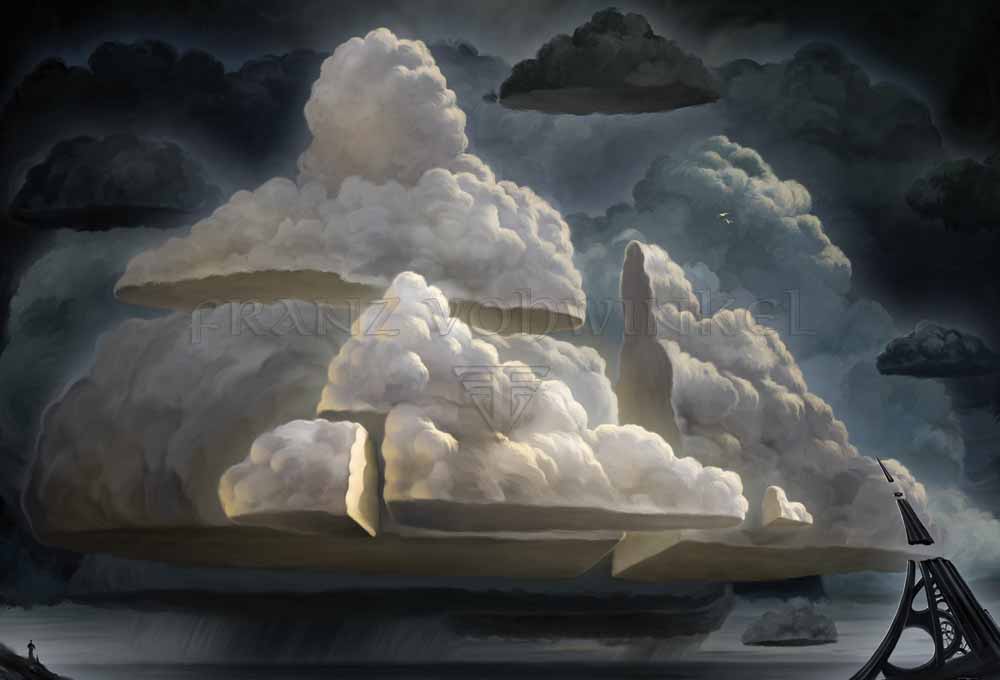
Esper Panorama | Illustration by Franz Vohwinkel
Esper is a primarily blue-aligned shard with white and black as secondary colors. The realm is one where control and purpose are overvalued and savagery is tamped down. Artificers, created machines mimicking the manner of animals, from birds to drakes to sphinxes. Esper goes for control elements, adds in color-oriented artifacts and attacks or mills unabated.
Grixis: BRU
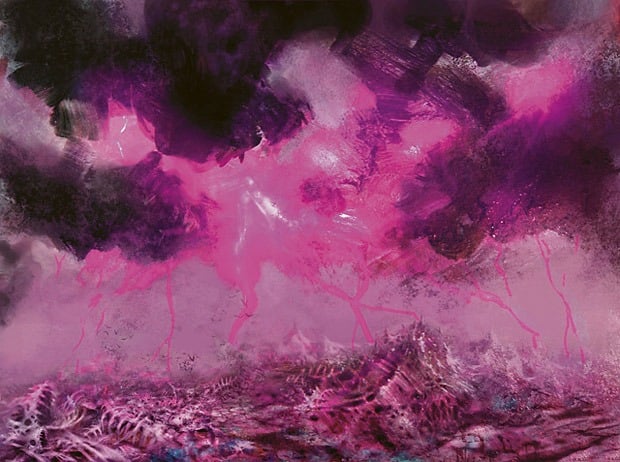
Grixis Panorama | Illustration by Nils Hamm
Grixis is a primarily black-aligned shard with red and blue as secondary colors. The realm is basically death, your pick of the seven deadly sins, and the undead abound. This is full of creatures with ETB and death triggers, enchantments to tax your opponent’s actions, and destruction/burn, if you benefit from destroying creatures (your opponents or your own) you’re playing Grixis right.
Jund: RBG
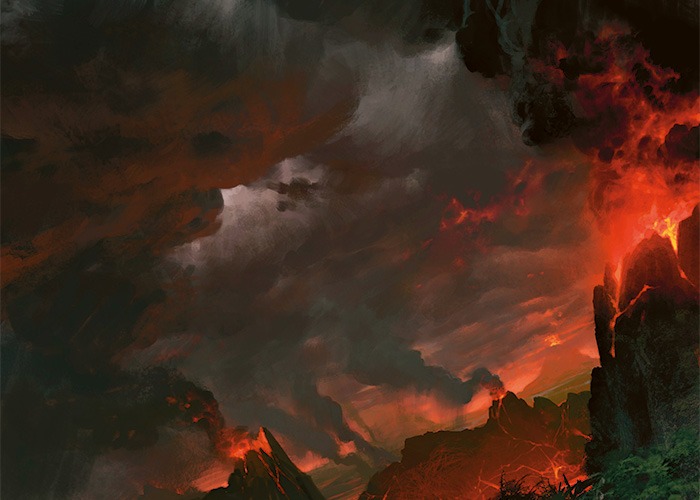
Jund Panorama | Illustration by Jaime Jones
Jund is a primarily red-aligned shard with black and green as secondary colors. The realm is very wild and free, an eat-or-be-eaten mentality is rampant. Jund is just as much the fast aggro of red plus the destruction-oriented control and sacrifice of black and the ramp potential of green. You could say Jund is a resourceful source of jank.
Naya: GRW
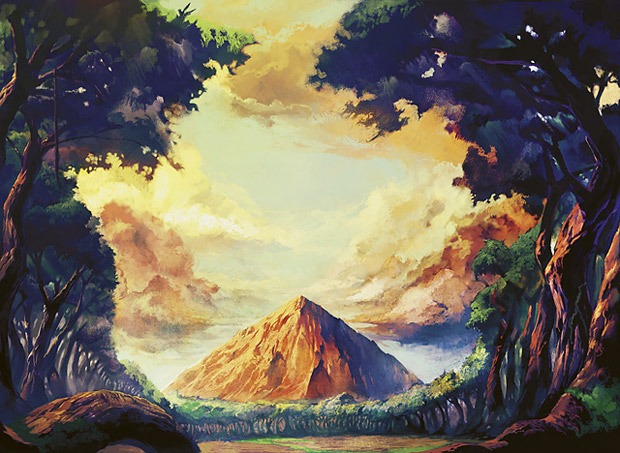
Naya Panorama | Illustration by Hideaki Takamura
Naya is a primarily green-aligned shard with red and white as secondary colors. The realm is a vast rainforest, brimming with the most lifeforms out of any of Alara’s planes. It’s a paradise with behemoths that indiscriminately crush anything and everything in their paths. Naya is very much like playing mono-green on hypergrowth, your smaller creatures hold the line and enable your larger creatures to hit the field earlier than they should.
Abzan: WBG
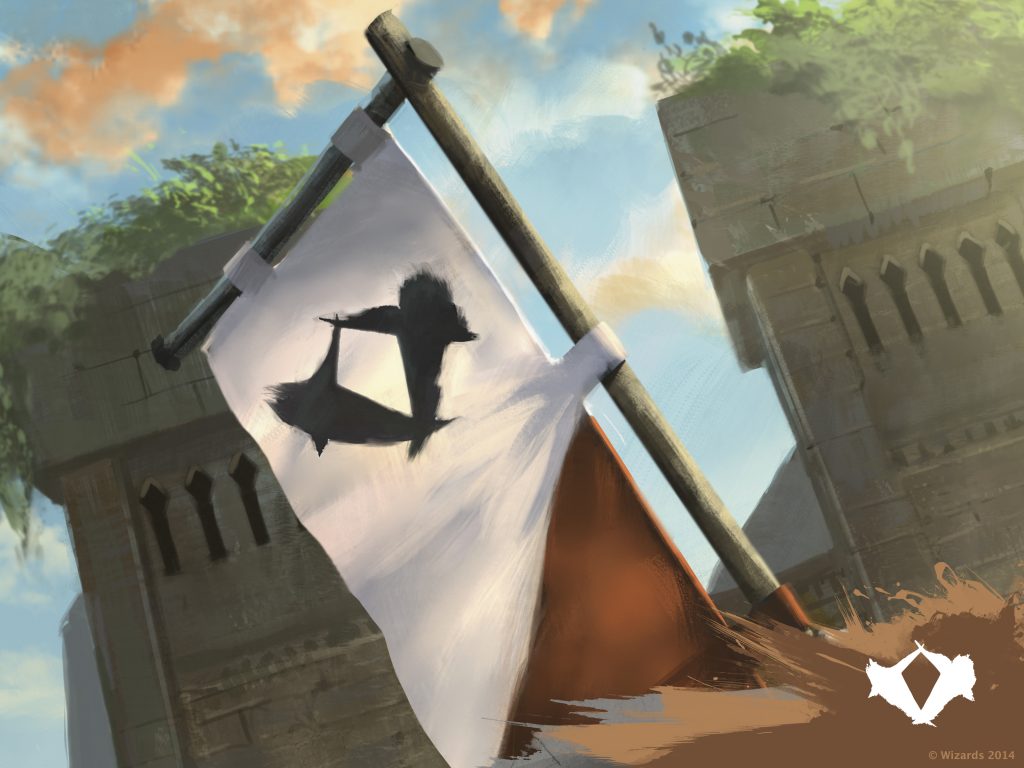
Abzan Banner | Illustration by Daniel Ljunggren
Abzan is the color wedge focused on white, with black and green, combining to admire the ancient dragons’ aspect of endurance. Abzan strategy revolves around keeping permanents on the battlefield with access to outlast or bolster, a fair bit of reanimation to bring them back should they fall, and lifegain.
Jeskai: URW
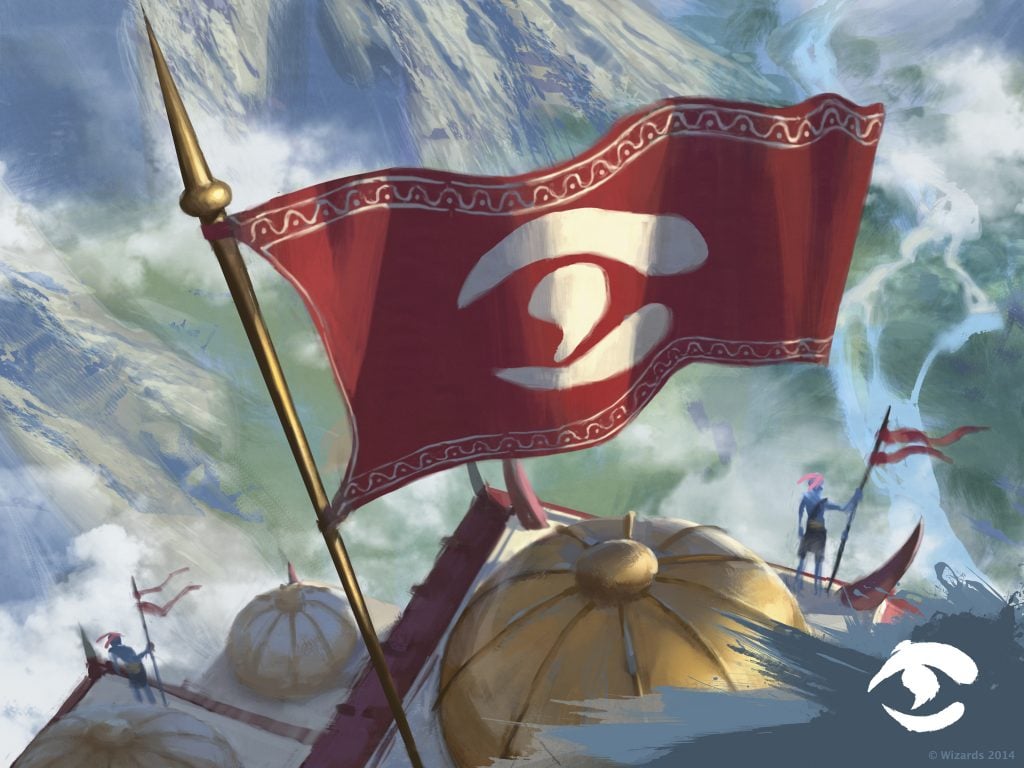
Jeskai Banner | Illustration by Daniel Ljunggren
Jeskai Way has the color wedge focused on blue with, red, and white on each side admiring the cunning that the ancient dragons possessed.
The Jeskai focus on cards that grow shows itself in abilities like prowess, and the aim to protect swift strikes with blue counterspells to disrupt and red burn spells to clear a path.
Sultai: BGU

Sultai Banner | Illustration by Daniel Ljunggren
Sultai focuses its color wedge on black with green and blue as secondary colors. This group admires the ruthlessness of the ancient dragons. The necromancer and reanimation traits of the Sultai maximize self-mill and delve to use the chaff in your graveyard.
Mardu: RWB

Mardu Banner | Illustration by Daniel Ljunggren
Mardu's color wedge puts red on point with white, and black, to admire the speed of the ancient dragons.
You want to play Mardu fast and hard. The red represents getting things out fast, white for the cheap price, and black for the less-than-fun keywords. The keywords raid and dash can finish your opponent before they have much to work with.
Temur: GRU

Temur Banner | Illustration by Daniel Ljunggren
Temur green-focused color wedge, with red and blue as adjacent colors, in awe of the ancient dragons’ aspect of savagery. Here you find lots of big creatures making smaller creatures, and smaller creatures making bigger creatures. This group mashed together a hustle and bustle of big creatures, a little more rummaging than looting, and spell-copying shenanigans.
Other Combo Names
Tarkir Clans
Each of the Tarkir clans also go by other names, but are often called by either the Tarkir or Ikoria clan/Triome names. There are also some others that aren’t used as often. Take a look:
| Tarkir combo names | Ikoria combo names | Planar Chaos combo names | Apocalypse combo names | The Weirdos |
|---|---|---|---|---|
| Jeskai | Raugrin | Numot | Raka | USA / American / Patriot |
| Mardu | Savai | Oros | Dega | Rorzhov (Orzhov + R) |
| Sultai | Zagoth | Vorosh | Ana | BUG |
| Temur | Ketria | Intet | Ceta | Grizzet (Izzet + G) / RUG |
| Abzan | Indatha | Tenab | Necra | Junk |
Strixhaven Schools
The 2-color combinations were also given slightly different identities for the colleges in Strixhaven. Here they are mapped to their Ravnica guild counterparts:
| Ravnica Guild Name | Strixhaven College Name |
|---|---|
| Orzhov | Silverquill |
| Boros | Lorehold |
| Simic | Quandrix |
| Izzet | Prismari |
| Golgari | Witherbloom |
Streets of New Capenna Families
Streets of New Capenna brought with it a heavy emphasis on 3-color combinations, showcasing their differences in style and gameplay through a crime family-themed set. Each color combo is a different family with its own crime lord heading it.
Here's the name for each family and its respective color combination:
| Colors | Mana Symbols | New Capenna family |
|---|---|---|
| UWB | Obscura | |
| BRU | Maestros | |
| RGB | Riveteers | |
| GRW | Cabaretti | |
| WGU | Brokers |
Obscura: WUB ()
Obscura is the white-blue-black combination of gifted magicians and wizards who enjoy delving into the power of Magic to manipulate, deceive, and run schemes without disruption from the other families or government.
Maestros: UBR ()
The Maestros are ultra-wealthy vampires who align with blue, red, and black. They keep up a false front of being art collectors while in reality, they're a group of elite assassins only concerned with growing their wealth and increasing in power.
Riveteers: BRG ()
The Riveteers are associated with black, red, and green and are a collection of rowdy, burly, and strong artisans and workers. They're pros at demolition and intimidation and respect to a mysterious draconic leader in the underground of New Capenna.
Cabaretti: RGW ()
The red, green, and white “party monsters” of druids call themselves the Cabaretti. They're known for hosting tremendous feasts and dances. They use magic secretly to sway and influence the general population to keep them in good standing but swiftly discard anyone who isn’t paying their dues.
Brokers: GWU ()
The Brokers are quite literally the “demonic lawyers” who work with green, white, and blue mana. By day they handle the bureaucracy of New Capenna and anything mundane or legal-related, but by night they believe in a sort of top-secret “doomsday prophecy.” They never fail to project influence into every aspect of life in New Capenna.
Four-Color Combinations
All of the 4-color combos come from the Nephilim creature type introduced in Guildpact. Lore-wise, they were Old Gods (monsters with very limited intelligence) who were the symbols of Ravnica well before the time of the Guildpact. They were the main antagonists (if you can call something whose main drive is to mindlessly feed, an antagonistic quality) of the storyline of the set.
While the Nephilim themselves didn’t get much play, they gave us names for these combinations. Sadly, their main purpose is to allow you the freedom to build in any of the colors, with some level of restriction since one of the colors is left out. Here are the combos along with their Nephilim name:
| Colors | Mana Symbols | Combo Name | Nephilim |
|---|---|---|---|
| UBRG | Glint-Eye | Glint-Eye Nephilim | |
| BRGW | Dune-Brood | Dune-Brood Nephilim | |
| RGWU | Ink-Treader | Ink-Treader Nephilim | |
| GWUB | Witch-Maw | Witch-Maw Nephilim | |
| WUBR | Yore-Tiller | Yore-Tiller Nephilim |
Five-Color: WUBRG “Rainbow”
WUBRG gets its name from the shorthand for the colors. There is no mythical beast called the Woo-Burg, although it definitely sounds like something for an Un-set.
While you would think that playing a deck like this would be amazing, freeing, make you wonder why no one else does this, you’re only partially correct. Yes, having access to all colors does allow you to play pretty much anything you want, but you can think of it in terms of total number of pips (the mana symbols of required colors in a mana cost) and the more pips on a card, the harder it is to play in a five-color deck.
You need more mana fixing than any other deck. Many have several additional sources of mana beyond your lands (such as mana rocks and mana dorks), and hope that you’re able to get the mana needed to even play those.
If you’re playing a 5-color deck, you’re should be very aware of the costs and are working around them or line yourself up for a single big combo. Five-color Commander is another story if that's your shtick, since color identity opens up a world of possibilities and you have a ton of mana-fixing options.
No Color
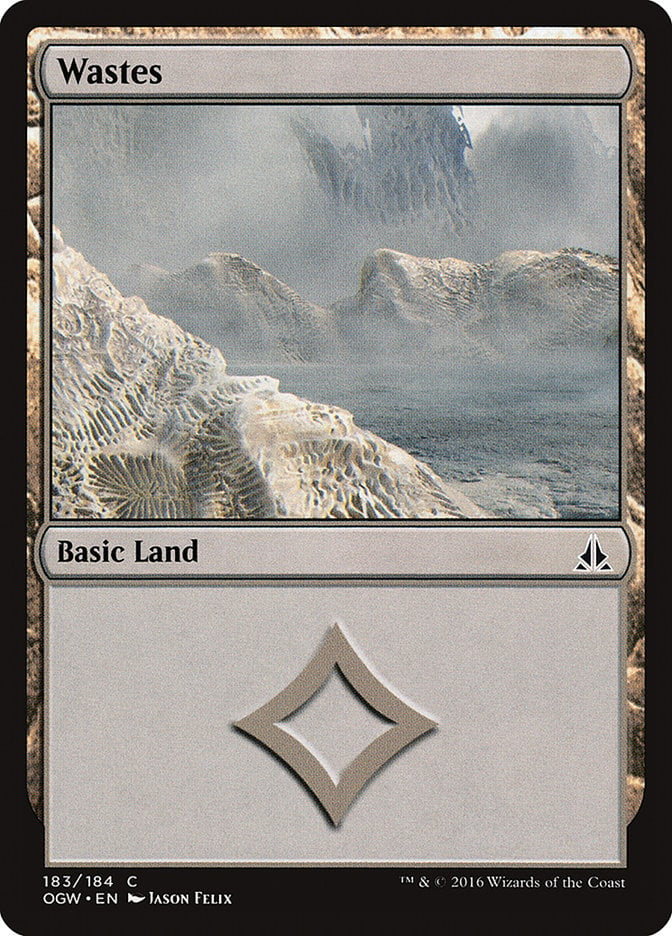
Yep, you can have an entire deck that does not care what color mana you use or, for added difficulty, you can have a deck that requires colorless mana. Colorless decks tend to be either artifact-only decks, ones that use a lot of Phyrexian mana, or everyone’s favorite Eldritch horrors, the Eldrazi. If you go this route, I would suggest saving on the dual or tri-lands unless they have an additional added bonus (like shock lands or scry lands) or investing in some Wastes since you’ll need the colorless kind.
Why Color Combos Matter (Sometimes)
The good thing about color combos is you can do with this info whatever you want, really. Technically speaking, all of the combos are viable ways to play Magic.
Some considerations to keep in mind along with the format you’re playing:
- The more mana colors you include, the more possibility that in a given game, you’ll be hoping for access to a color that you don’t have yet.
- While dual- and tri-lands do exist, only the original dual lands are consistently as fast and versatile as basic lands.
- Tutoring, while a thing, isn’t equally available in all colors and can take up a place in your decks that other cards could better utilize.
A lot of the 3-color decks worked wonderfully in their respective sets and meta-games, but their mileage may vary outside of them. There is no “wrong” way to play Magic, but sometimes the synergies and quality of cards aren’t there to make them playable at the competitive level.
The best suggestion I can make is if you want to be competitive, look up what’s working in the pro-circuit using the Arena Tutor metagame tab.
The Best Combo for You
Which color combination should you play? That completely depends on your personality and play style.
If you’re someone who enjoys sitting down and playing mostly with your own toys, then mono-red, mono-green, Boros, Golgari, or any combinations that are mostly red or green are most likely your style.
If you want to make sure you get to beat face unimpeded, look at mono-white, mono-blue, Azorius, or Selesnya.
Want to ruin everyone else’s fun? Look at mono-blue, mono-black, Dimir, or Esper.
What I’m getting at is that there is always a way to play the game that makes it the most fun for you specifically. Just don’t be surprised if your brand of fun and someone else’s don’t play well together.
The Best Color Combo
Objectively, the “best” color combo period would be hard to define, since every set tends to change things enough to give each combo their turn in the spotlight. In terms of popularity, 2-color and 3-color tend to be the combos that get the most play.
Ultimately, the best color combination is going to depend on what specific criteria you’re looking for.
Wrap Up

Better Than One | Illustration by Alex Konstad
Whew. Glad this was typed and not spoken. I hope you found this informative or at least that I’ve piqued your interest in trying new color combos. If you’re a newer player, be sure to check out our beginner’s guide and grab our app Arena Tutor.
Have you spotted something our list is missing? Do you have a question about how to better use the combos or some that you feel are underused in the current meta? Feel free to leave a comment below, or join us on our Discord server for a chat!
Follow Draftsim for awesome articles and set updates:
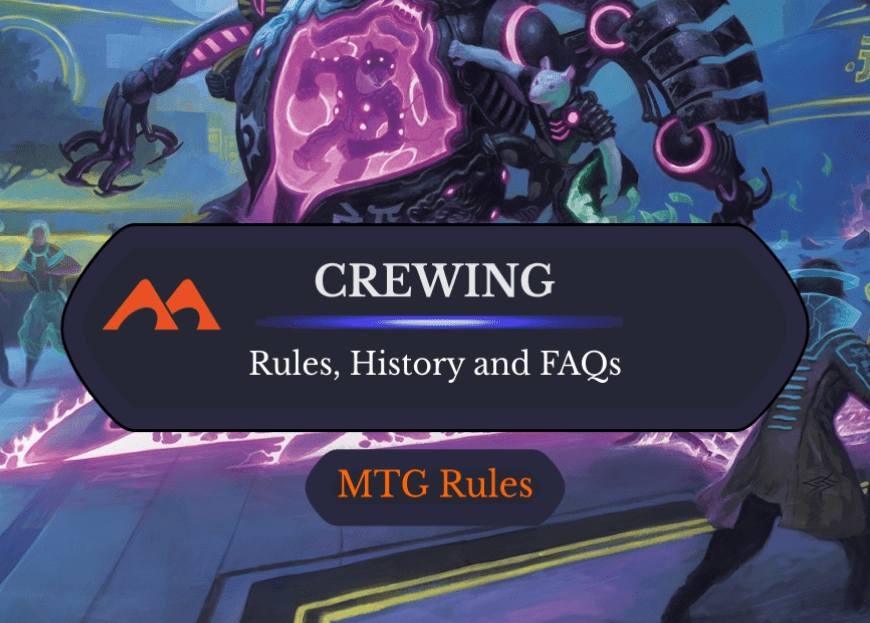
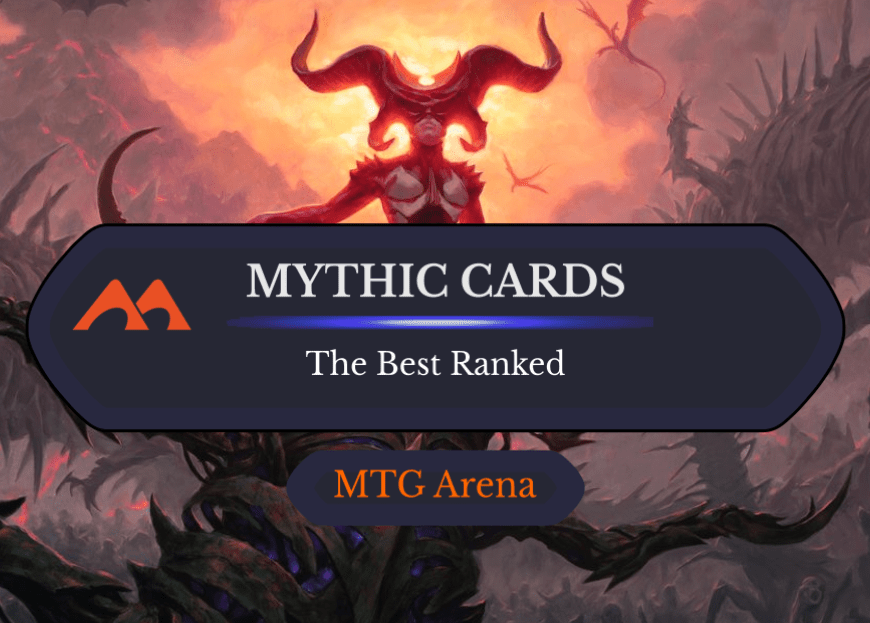
9 Comments
This article could use a brief description of the fact blue is abbreviated “U”, because reasons.
The description for Sultai says it contains aspects of Izzet, which is incorrect. Whats left is Simic, which can lend a bit of ramp to the mill and reanimation strengths of UB and BG
Yeah, that’s probably more appropriate. Thanks — I tweaked it to reflect that.
Wondering why you’re including the alternate names for the Wedges, but not the alternate names for the Strixhaven colour pairs?
Ask and you shall receive! Done.
Can’t emphasize enough how helpful this article was for a baby MTG player such as myself. I can play but building decks is another step I’m looking to achieve and this will absolutely be my reference. Thank you!
That’s awesome! So glad we helped you out.
As someone who played back in the Dark Ages and wandered back in with the D&D set, it’s really nice to have a article sum up all these short-hand names for color combos/guilds that are in common use now. I almost understand people now!
Welcome back to the game 🙂 Glad it helped!
Add Comment